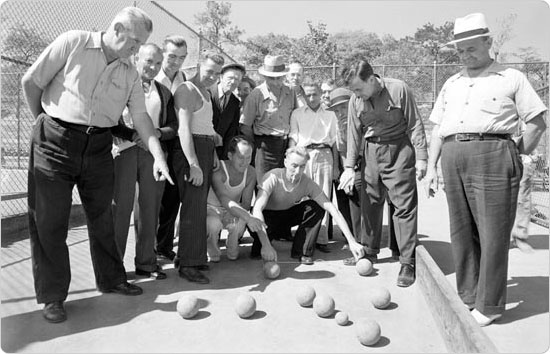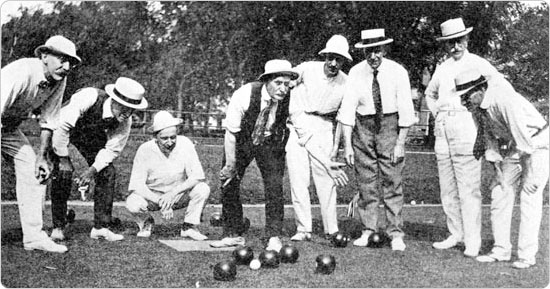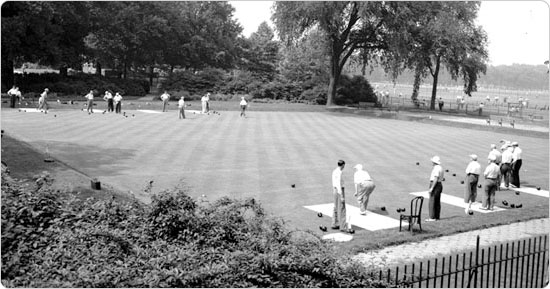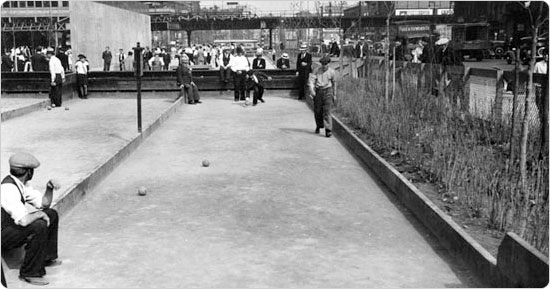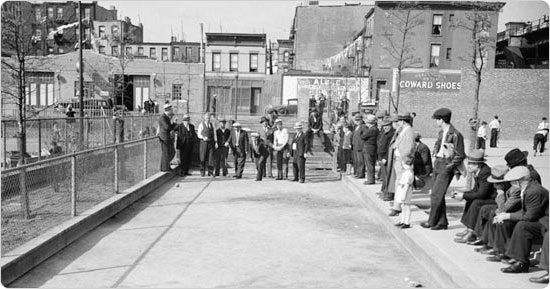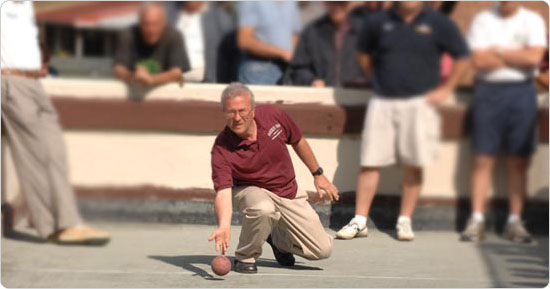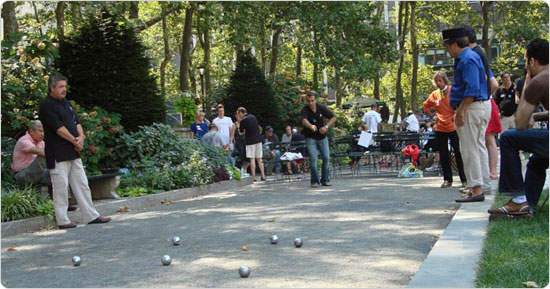History of Bowling, Boules, and Bocce in Parks
While basketball players sweat on courts and baseball players tough it out on the diamond, variations on the relatively more slowly paced game of "bowls" take place daily at sites across the city. Lawn bowling, boules (and pétanque), and bocce have a long history of being played in New York City parks. The New York Bowling Club, which plays on its distinctive green in Central Park near Sheep Meadow, has been active there since 1926. Bocce, which got its first park court in 1934, has been a feature at parks across the city since then. Today even boules are enjoying a renaissance at parks in Manhattan and Brooklyn. The games are accessible to all in that they do not require much equipment but remain challenging enough to make them fun to play.
Games where players roll or toss balls toward a target can be traced as far back as the Egyptians and Romans. Bocce, boules and lawn bowling are similar in that generally the object of all games is to toss or lob a larger ball from a distance, landing it closest to a smaller target ball. Bocce spread through Europe via the Roman Empire, and the English eventually embraced the game, which they developed into lawn bowling.
Lawn Bowling
Lawn bowling has a tradition in New York City dating back to its earliest Dutch beginnings. Bowling Green, the city's first park (officially designated as such in 1733), takes its name from lawn bowling matches held at the site perhaps as early as 1626. After Bowling Green was renovated in 1939, the Parks Department held a traditional lawn bowling exhibition there (which was repeated at the park's “268th birthday” in 2001).
Lawn bowling is similar to bocce and boules in that the goal is to land a “bowl” close to the “jack.” Lawn bowling differs in that teams play on 120-by-15-foot rinks within a large square green measuring 120 feet on each side. Greens are able accommodate up to eight games at a time.
Lawn bowling bowls are also not perfectly spherical like bocce balls—instead, lawn bowls have a “bias” that gives the balls a flattened appearance and which requires bowlers to curve their shots towards the jack. Lawn bowling greens call for a firm, smooth, level surface, accounting for their distinctive closely cropped grass. Thus, the greens require a great deal of careful maintenance and bowlers must wear proper footwear to protect the green.
Lawn bowling became popular in the city at the end of the 19th century and the beginning of the 20th century. The Brooklyn Lawn Bowling Club once used a green at Prospect Park's Parade Ground, one of eight clubs (along with New York Lawn Bowling Club) in the Metropolitan District Lawn Bowling Association, which had teams around New York and New Jersey. The green at the Parade Ground featured benches for spectators, and the results of the matches were reported in newspapers. The 1919 Brooklyn Annual Report noted that the Parade Ground lawns “were the scenes of many interesting games between Brooklyn teams and teams from out of town.” The 1920 Annual Report noted that the bowling greens at the Parade Ground were “extremely popular throughout the season.” A clubhouse was built in 1933.
The Brooklyn Lawn Bowling Club's “old timers” were profiled in The New York Times in 1949, at which time the paper noted the club's Scottish, Irish, and Swedish roots. Another profile in 1974 reported the decline of lawn bowling in Brooklyn, noting that the green was “only being used by a small band of senior citizens,” and that the game—“similar to boccie” (underscoring the reverse in popularity for the sport, which at one point was more popular than bocce) —hadn't really caught on with younger generations. Today, the bowling house serves as the Prospect Park Youth Resource Center, which provides information on park events, youth programming, and how youth can become more involved in community activities.
Another group, the New York Lawn Bowling Club, has been active in Central Park at their green near Sheep Meadow since 1926 and continues the tradition to this day. Its members bowl several days a week during lawn bowling season, which lasts from May to October. The club offers free lessons to prospective bowlers, which are given when greens are open; the club provides "bowls" for prospective players to use. (The picturesque green also is used for croquet by the New York Croquet Club.)
Bocce
The modern game of bocce (also sometimes written as “bocci” or “boccie”) developed in Italy during the 19th century, and now has well-defined regulations. Played on a court of crushed stone, rather than on the grass lawns used in English lawn bowling, bocce players attempt to throw balls closest to a target ball called a “pallino” (as opposed to lawn bowling's “jack”.) Although it is enjoyed by all people, initially bocce was played predominantly by Italian communities, especially those in Philadelphia and New York.
The first bocce courts in New York City parks were established by Mayor La Guardia in 1934 at Thomas Jefferson Park in Manhattan, in the middle of what was then a predominantly Italian neighborhood. A Parks Department press release from the time noted, “In order to furnish his former neighbors an opportunity of playing the popular Italian game of Bocce, Mayor La Guardia has requested the Park Department to install courts in Thomas Jefferson Park at 111th Street and First Avenue, Manhattan.” The Parks Department built many new playgrounds during this era, and bocce courts were included at many of these sites.
The popularity of bocce meant that by the 1950s, bocce courts had became common features alongside shuffleboard courts, handball courts, and horseshoe pits in playgrounds across the city. The more “passive” sort of recreation that bocce encouraged fit with the philosophy of the Moses Administration to create all-purpose areas that welcomed users of all ages and interests. By the 1950s, Parks Department counted bocce as one of the “popular activities that lure New Yorkers to out-of-town vacation resorts [that] can be found within a reasonable distance of every community in the five boroughs.”
In 1958, bocce courts could be found at 27 parks across the city. Also in 1958, Parks hosted its first bocce tournament, sponsored by the Schaefer Brewing Company. Teams competed in elimination matches at the borough level, and the ten successful teams moved on to citywide finals held at Louis Cuvillier Playground in East Harlem. Manhattan residents Ciro Carlino and Peter Favuzza won the tournament, earning wristwatches donated by Schaefer. The report in The New York Times noted that the 50-year-old Carlino's “curving wizardry with the boccia drew cheers that rent the air. Without much of a wind-up, he rolls the boccia fifty feet, and then it makes a vertical turn, practically hugging the pallini.”
Fifty years later, bocce seems just as popular as it was when Mayor La Guardia decreed the first courts. Today, there are bocce courts at 39 parks across the city. One of the most famous is at William F. Moore Park in Queens— known as “Spaghetti Park” to locals—where the Corona Italian enclave decorated its local bocce court with festive lighting, and where the court in the middle of the square literally serves as the center of the neighborhood, attracting young and old whenever the weather permits. In addition, a contingent of Maltese immigrants comes together to play bocce at J.J. Walker Park near the marble sarcophagus on the north side of the park that was dedicated in 1834 to three fallen firemen.
Boules or Pétanque
Boules (or Pétanque) is the French version of bocce. Instead of a pallino or jack, the target ball is known as a “cochonnet.” For some time, members of the French community played pétanque in Central Park on Great Hill near 106th Street. In the 1960s a team started with help from the restauranteurs Pierre and Rene Pujol (their Rene Pujol restaurant off of Times Square closed in 2008 after over 30 years of being in business) called “La Boule New Yorkaise.” The team was part of the American Pétanque Association and played against teams from New York and New Jersey.
La Boule New Yorkaise continues to play pétanque in Washington Square Park and Bryant Park. The group also offers free pétanque lessons to anyone who is interested. Other pétanque aficionados play at McCarren Park in Greenpoint, Brooklyn and Carroll Park in Carroll Gardens, Brooklyn, and in Central Park in the sand at Heckscher Ballfield #3 and the cinder bridle path near Tavern on the Green.
Learn to Play Pétanque!
Related Links
Bocce Courts
Parks’ Annual Citywide Bocce Tournament
It's My Park Annual Bocce Tournament video segment
La Boule New Yorkaise
New York Lawn Bowling Club BeFitNYC: Search for fitness opportunities based on interest, age, and location
